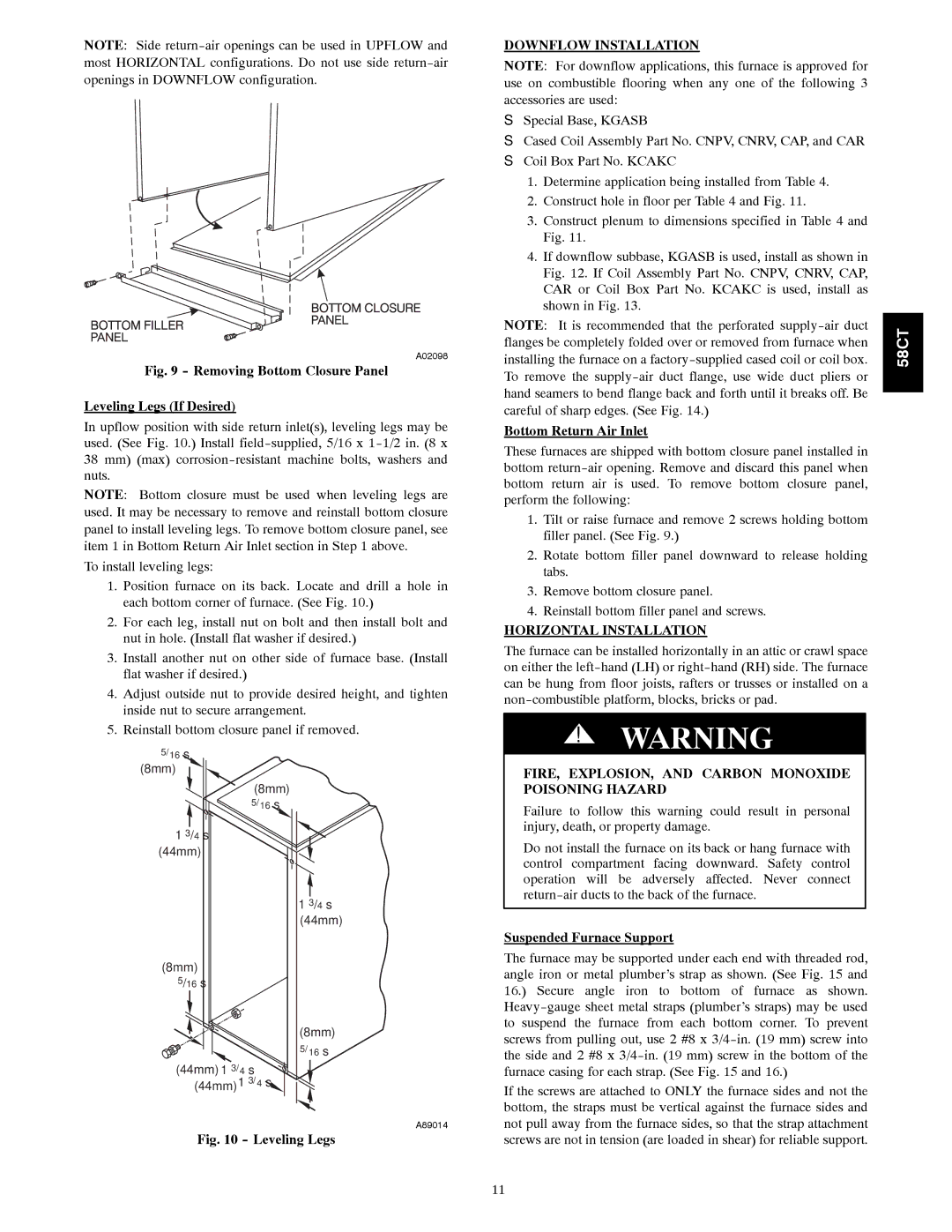
NOTE: Side
A02098
Fig. 9 - Removing Bottom Closure Panel
Leveling Legs (If Desired)
In upflow position with side return inlet(s), leveling legs may be used. (See Fig. 10.) Install
38mm) (max)
NOTE: Bottom closure must be used when leveling legs are used. It may be necessary to remove and reinstall bottom closure panel to install leveling legs. To remove bottom closure panel, see item 1 in Bottom Return Air Inlet section in Step 1 above.
To install leveling legs:
1.Position furnace on its back. Locate and drill a hole in each bottom corner of furnace. (See Fig. 10.)
2.For each leg, install nut on bolt and then install bolt and nut in hole. (Install flat washer if desired.)
3.Install another nut on other side of furnace base. (Install flat washer if desired.)
4.Adjust outside nut to provide desired height, and tighten inside nut to secure arrangement.
5.Reinstall bottom closure panel if removed.
5/16″
(8mm)
(8mm)
5/16″
1 3/4″ (44mm)
1 3/4″ (44mm)
(8mm)
5/16″
(8mm)
5/16″
(44mm) 1 3/4″ ![]()
![]()
![]() (44mm)1 3/4″
(44mm)1 3/4″ ![]()
A89014
Fig. 10 - Leveling Legs
DOWNFLOW INSTALLATION
NOTE: For downflow applications, this furnace is approved for use on combustible flooring when any one of the following 3 accessories are used:
SSpecial Base, KGASB
SCased Coil Assembly Part No. CNPV, CNRV, CAP, and CAR S Coil Box Part No. KCAKC
1.Determine application being installed from Table 4.
2.Construct hole in floor per Table 4 and Fig. 11.
3.Construct plenum to dimensions specified in Table 4 and Fig. 11.
4.If downflow subbase, KGASB is used, install as shown in Fig. 12. If Coil Assembly Part No. CNPV, CNRV, CAP, CAR or Coil Box Part No. KCAKC is used, install as shown in Fig. 13.
NOTE: It is recommended that the perforated
Bottom Return Air Inlet
These furnaces are shipped with bottom closure panel installed in bottom
1.Tilt or raise furnace and remove 2 screws holding bottom filler panel. (See Fig. 9.)
2.Rotate bottom filler panel downward to release holding tabs.
3.Remove bottom closure panel.
4.Reinstall bottom filler panel and screws.
HORIZONTAL INSTALLATION
The furnace can be installed horizontally in an attic or crawl space on either the
!WARNING
FIRE, EXPLOSION, AND CARBON MONOXIDE POISONING HAZARD
Failure to follow this warning could result in personal injury, death, or property damage.
Do not install the furnace on its back or hang furnace with control compartment facing downward. Safety control operation will be adversely affected. Never connect
Suspended Furnace Support
The furnace may be supported under each end with threaded rod, angle iron or metal plumber’s strap as shown. (See Fig. 15 and 16.) Secure angle iron to bottom of furnace as shown.
If the screws are attached to ONLY the furnace sides and not the bottom, the straps must be vertical against the furnace sides and not pull away from the furnace sides, so that the strap attachment screws are not in tension (are loaded in shear) for reliable support.
58CT
11
